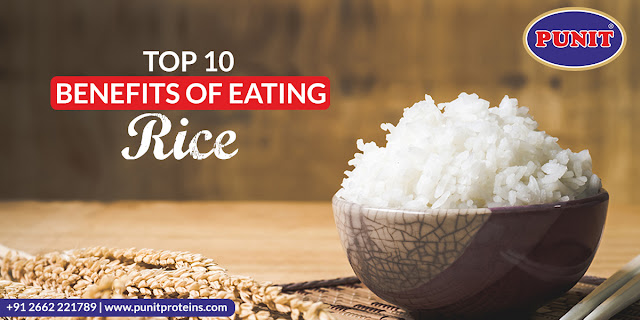Nutritional Information and Types of Wheat used in India
Wheat:
It's derived from a grass (Triticum) that's grown in a wide range of shapes over the globe. Bread wheat, also known as ordinary wheat, is the most prevalent type of wheat. There is a tight genetic relationship between spelt, durum, einkorn, emmer, as well as Khorasan wheat. Looking for affordable Sharbati wheat price in Vadodara, Punit Proteins is the best place for you.
Both white and whole wheat flour are necessary components of baked goods. Wheat is used to make a variety of foods, including noodles, pasta, bulgur, semolina, as well as couscous.
Gluten, a protein found in wheat, can produce an adverse
immune response in those who are sensitive to it. Increase your immunity and
give your body the essential nutrients it needs with high quality grains, buy sharbati wheat today from Punit
Proteins.
Nutritional information:
Wheat is mostly composed of carbs but does have a little amount of protein. Since we're looking at one of the highest-quality wheat kinds in India, we might as well find out what it offers in terms of nutrition, too. These elements can be found in all of India's highest-quality wheat types. You can place a bulk order for Sharbati wheat online from reputable companies like Punit Proteins, that are guaranteed to include only the highest quality nutrients.
What follows is the breakdown of the 100 grams of whole-grain
wheat flour's worth of nutrients.
●
Calories : 340
●
Water : 11%
●
Protein : 13.2
grams
●
Carbs : 72
grams
●
Sugar : 0.4
grams
●
Fibre : 10.7
grams
●
Fat : 2.5 grams
Carbs:
Carbohydrates make up the bulk of wheat's composition, as they do of all cereal grains. Starch is the most abundant form of carbohydrate in plants, making up 90+ per cent of the carbohydrate content in wheat. The effects of starch on the sugar levels in the blood are determined by how well the body can digest the substance.
In particular, people with diabetes should avoid foods with a
high digestibility since they might cause a dangerous spike in blood sugar
levels after eating. The higher amount of glycemic index (GI) of both refined
and whole wheat makes them unsuitable for diabetics, as do refined rice and
potatoes.
Fibre:
When compared to refined wheat, whole wheat contains a plethora of fibre. Twelve to fifteen percent of whole-grain wheat's dry weight comes from fibre. Since bran is where you'll find most of the fibre, it gets removed during milling, leaving refined flour relatively fiber-free. Wheat bran is mostly made up of the hemicellulose fibre arabinoxylan. The remaining fraction is largely composed of cellulose.
The vast majority of the fibre present in wheat is insoluble,
meaning it remains largely intact throughout the digestion process and helps to
increase stool volume. Some fibres actually act as food for those bacterias
that stay in your digestive tract.
Protein:
Wheat's protein content ranges from 7% to 22% by dry weight. Gluten is a family of proteins that can make up as much as 80% of a food's protein content. Wheat dough's unique elasticity and stickiness are largely attributable to this factor, making it an invaluable ingredient in breadmaking. The ingestion of wheat gluten may have adverse health effects in people who are sensitive to it.
Today we’ll learn about the variety of wheat in India that
are used to make different kinds of flour.
Types of Wheat in India:
Punit Proteins, like many other Indian brands, uses a blend
of different types of wheat to meet the dietary preferences of the country's
diverse population.
●
Khapli Wheat:
Khapli wheat, sometimes called Samba wheat, Emmer wheat, and Diabetic wheat, is grown extensively in India. It's one of India's highest-quality wheat options.
Benefits include reduced risk of
cardiovascular disease and improved glucose control in diabetics. It can reduce
cholesterol as well as glucose levels in the blood, making it a good choice for
those looking to lose weight or improve their health. Chapati made from khapli
wheat has a lot of fibre and may keep you full for longer than other types of
chapati.
●
Sharbati Wheat:
Sehore, Madhya Pradesh is the only
place where this particular variety of wheat is cultivated. The soil in this
area is potassium rich as well as receives an adequate rainfall, therefore the
wheat grown there is golden in colour and has a higher protein level than most
other types of wheat. Because of the grain's density and nutty flavour, these
chapatis are hearty yet surprisingly light and delightful. Buy sharbati wheat in Baroda
from Punit Proteins today and stay assured of the highest quality grains.
●
Common bread
wheat:
That's the most widely grown wheat
type worldwide, and it's widely grown in India. It can also be used to make
chapatis rich in protein content. This wheat cultivar is ideal for making
chapati. Indian dwarf wheat is a kind of common bread wheat that is indigenous
to India. Its grains are smaller and rounder than those of other types of
wheat. It has a light colour as well as a softer flavour than equivalent
American-grown grains. However, there is little difference in the nutrients
they provide.
●
Durum Wheat:
India is a major producer of durum wheat, that is often referred to as pasta wheat and/or macaroni wheat. It's also among India's top-tier wheat options.
This is due to the fact that semolina
is made from coarse wheat grains, which are subsequently used to make a wide
variety of pasta, noodle, and macaroni shapes. It's nutritional profile is very
comparable to that of regular bread wheat, and it is highly concentrated with
gluten. However, bread made using durum wheat flour will not rise properly
because it does not contain enough starch.



Comments
Post a Comment